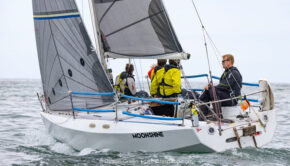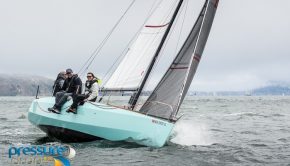Interest builds for California Offshore Race Week 2021
Published on May 11th, 2021
After its cancellation in 2020 due to the coronavirus pandemic, the California Offshore Race Week (CORW) is back in 2021 and will be the 5th edition of this series that combines three offshore sailing events. First held in 2016, CORW includes:
• Spinnaker Cup (San Francisco to Monterey, 88nm): May 29-30
• Coastal Cup (Monterey to Santa Barbara, 204nm): May 31 – June 1
• SoCal 300 (Santa Barbara to San Diego, 245nm): June 3-5
Prior to the launch of the SoCal 300 in 2015, the two existing events in Northern California, the Spinnaker Cup and the Coastal Cup, were standalone races. After seeing the popularity of the SoCal 300, there was growing interest in all three races being held in sequence. In 2016, it was agreed upon to combine all three races into one intense week of sailing down the coast.
Indeed, it is a bucket list trek down the coast starting in San Francisco with stops in picturesque Monterey Bay and Santa Barbara and ending in San Diego. For sailors wanting to limit their racing and stay closer to home, each of the individual events is also scored separately.
California Offshore Race Week continues to see growth in entries and returning sailors. As for the SoCal 300, the 2021 entry list of nearly 40 boats is the biggest in the race’s history.
This year, CORW will be scored as a single race from start to finish, counting points for corrected time overall finishes in the Spinnaker Cup, Coastal Cup, and SoCal 300. This change does away with the four leg score format the event had in the past.
“While it was a great concept, the way the ratings worked out, the same boats that won the contest were typically winners on each leg as well. Not that the winners didn’t deserve lots of praise, but it seemed a little overkill,” said Jeff Johnson, Race Director at San Diego Yacht Club and Race Officer for SoCal 300.
Returning for this year’s SoCal 300 is Michael Moradzadeh sailing his Santa Cruz 50 Oaxaca. Moradzadeh took first in the ORR-C class in the 2019 event.
“The challenge of sustained multi-day racing is rarely available to west coast racers,” said Moradzadeh. “This race, in warm waters, provides a great opportunity. It’s important to be knowledgeable on navigation and weather, of course, but it is equally as important that the crew stays engaged, alert, and active all the way through.”
Another competitor in the SoCal 300 is John Raymont sailing his Ker 51 Fast Exit II. Raymont has sailed the SoCal 300, finishing first in class and second overall in the 2019 running of the event.
“The SoCal 300 course is the sole local event that takes boats 100nm offshore into the ‘real ocean’,” said Raymont. “This includes waves and wind not found in coastal races. In 2018, winds were mid-30s, so no spinnaker was flown, but the boat was hitting 18-knots on the long leg to the virtual mark.
“In 2019, we had near 30-knots on the long leg to the virtual mark and flew our A3, passing all other boats except the largest leading boats. This year, we’re coming in with a strong passion to win, but safely executed in a seamanship manner respectful of the sea.”
The 2021 entry list welcomes over a dozen first time entrants to the regatta.
Rudolph Hasl, sailing J/145 Palaemon, recently came in second in class in SDYC’s Yachting Cup. This is the team’s first SoCal 300, but they have participated in SDYC’s old Bishop Rock Race, which had a similar course.
“It is critical to prepare mentally for this type of race by making sure the logistics are thought through, by having crew members who are comfortable with the challenges of nighttime sailing, by making sure that the crew schedules are arranged to provide for rest time, and to make sure that we have the sails available for the variety of wind conditions we may face,” said Hasl.
“For the race itself, creating a team is critical. The boat needs a team that enjoys working together and knows the boat and its sailing conditions very well. We all need to depend on one another during a race of this nature. We need skilled drivers and trimmers. We need the crew to be able to adjust during the race to the changing conditions, including sail changes and the ability to take care of problems that are likely to arise.”
Twenty-two out of the 38 current entries are also registered to sail in this summer’s Transpac Race, one of which is Chris Sheehan’s team sailing the Pac52 Warrior Won (previously BadPak).
“Our team is looking forward to getting some great training conditions for the Transpac Race along with some solid competition,” shared crewman Collin Leon. “We have put a lot of time in over the past year into crew work, sail plan, and boat optimization. Our big challenge will be to put all of those components together so we can race as efficiently as possible. While Transpac will be more of a marathon and less of a sprint, the SoCal 300 serves as great preparation.”
During each stop down the coast, there will be skipper’s meetings held prior to each race and a mandatory check-in. Each club participating as a finishing location will hold their own awards ceremony. The SoCal 300 ending at San Diego Yacht Club, will host an awards ceremony for the SoCal 300 and the entire CORW series as it is the final stop for the week.









 We’ll keep your information safe.
We’ll keep your information safe.